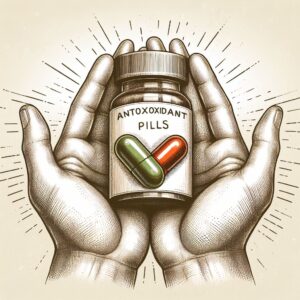The idea is simple, with aging, levels of the antioxidant metabolite glutathione decline and as a result there’s an increase of oxidative damage and mitochondrial dysfunction (1,2). So in theory you should want to increase the levels of glutathione.
The building blocks to make glutathione include the amino acids glycine and cysteine, and supplementing with these amino acids (termed ‘GlyNAC,’ where ‘Gly’ stands for glycine and cysteine is provided as N-acetylcysteine, or ‘NAC’) has indeed been shown in humans to restore levels of glutathione (2).

(image generated by AI)
Following those positive results, a placebo-controlled randomized clinical trial was conducted in older humans to test the effects of GlyNAC, which was published in 2023 and came out with quite an impressive title: “Supplementing Glycine and N-Acetylcysteine (GlyNAC) in Older Adults Improves Glutathione Deficiency, Oxidative Stress, Mitochondrial Dysfunction, Inflammation, Physical Function, and Aging Hallmarks” (3). This, paired with findings in mice that GlyNAC increases lifespan (4) and prevents age-related cognitive decline (5), makes GlyNAC a very interesting compound to look more into.
Here are three considerations before running out to supplement with GlyNAC:
(I) the human clinical trial was small, only 12 participants took GlyNAC (8 men, 4 women). These participants had a median age of 71. More studies are needed to see if the effects hold true in replication, in both men and women, at what age it might be appropriate, and whether it’s for sedentary or also active individuals.
(II) GlyNAC contains NAC. Though NAC has a historically well-defined safety profile, recent studies have suggested it may initiate the formation of cancers in higher doses (6,7), so more research is definitely needed before it’s a mainstream aging treatment. As a side note, NAC is the main therapy for acetaminophen toxicity. A recent FDA ruling therefore declared that supplements containing NAC are technically illegal in the US (since it’s a drug and not a supplement) (https://www.fda.gov/food/cfsan-constituent-updates/fda-releases-final-guidance-enforcement-discretion-certain-nac-products)
(III) Exercise also helps maintain glutathione levels with aging. The theory behind taking GlyNAC is to increase glutathione. Though exercise has a complex relationship with endogenous oxidative stress systems (depleting them upon the oxidative stress produced by exercise but repleting them more robustly on the long term), we know that exercise is likely to maintain glutathione levels with age (8,9), with likely far more pleiotropic beneficial effects than just improved glutathione. So its probably way better to just exercise more while aging instead of taking GlyNAC, but more research is needed.
These considerations of course haven’t stopped an industry from moving forward with GlyNAC (10), and indeed more research may prove its benefit in treating aging. At this stage though a good old-fashioned workout might be your best bet to get the benefits suggested by GlyNAC. A combination of both aerobic exercise training and circuit weight training has been shown to benefit glutathione the most compared to either alone (8).
Going deeper:
(1) Wu G, Fang YZ, Yang S, Lupton JR, Turner ND. Glutathione metabolism and its implications for health. J Nutr. 2004;134(3):489–492. doi:10.1093/jn/134.3.489
(2) Sekhar RV, Patel SG, Guthikonda AP, et al. Deficient synthesis of glutathione underlies oxidative stress in aging and can be corrected by dietary cysteine and glycine supplementation. Am J Clin Nutr. 2011;94(3):847–853. doi:10.3945/ajcn.110.003483
(3) Kumar P, Liu C, Suliburk J, Hsu JW, Muthupillai R, Jahoor F, Minard CG, Taffet GE, Sekhar RV. Supplementing Glycine and N-Acetylcysteine (GlyNAC) in Older Adults Improves Glutathione Deficiency, Oxidative Stress, Mitochondrial Dysfunction, Inflammation, Physical Function, and Aging Hallmarks: A Randomized Clinical Trial. J Gerontol A Biol Sci Med Sci. 2023 Jan 26;78(1):75-89. doi: 10.1093/gerona/glac135. PMID: 35975308; PMCID: PMC9879756.
(4) Kumar, P., et al. (2022) GlyNAC (Glycine and N-Acetylcysteine) Supplementation in Mice Increases Length of Life by Correcting Glutathione Deficiency, Oxidative Stress, Mitochondrial Dysfunction, Abnormalities in Mitophagy and Nutrient Sensing, and Genomic Damage. Nutrients. doi.org/10.3390/nu14051114.
(5) Kumar P, Osahon OW, Sekhar RV. GlyNAC (Glycine and N-Acetylcysteine) Supplementation in Old Mice Improves Brain Glutathione Deficiency, Oxidative Stress, Glucose Uptake, Mitochondrial Dysfunction, Genomic Damage, Inflammation and Neurotrophic Factors to Reverse Age-Associated Cognitive Decline: Implications for Improving Brain Health in Aging. Antioxidants (Basel). 2023 May 4;12(5):1042. doi: 10.3390/antiox12051042. PMID: 37237908; PMCID: PMC10215265.
(6) Zhang VX, Sze KM, Chan LK, Ho DW, Tsui YM, Chiu YT, Lee E, Husain A, Huang H, Tian L, Wong CC, Ng IO. Antioxidant supplements promote tumor formation and growth and confer drug resistance in hepatocellular carcinoma by reducing intracellular ROS and induction of TMBIM1. Cell Biosci. 2021 Dec 19;11(1):217. doi: 10.1186/s13578-021-00731-0. PMID: 34924003; PMCID: PMC8684635.
(7) https://www.science.org/content/blog-post/n-acetyl-cysteine-warning-shot
(8) Elokda AS, Nielsen DH. Effects of exercise training on the glutathione antioxidant system. Eur J Cardiovasc Prev Rehabil. 2007 Oct;14(5):630-7. doi: 10.1097/HJR.0b013e32828622d7. PMID: 17925621.
(9) https://oamjms.eu/index.php/mjms/article/view/3837
(10) Baylor College of Medicine holds the patent for the combination of Glycine and NAC (GlyNAC). It is currently licensed to Nestlé Health Science for use in Celltrient™ Protect.
